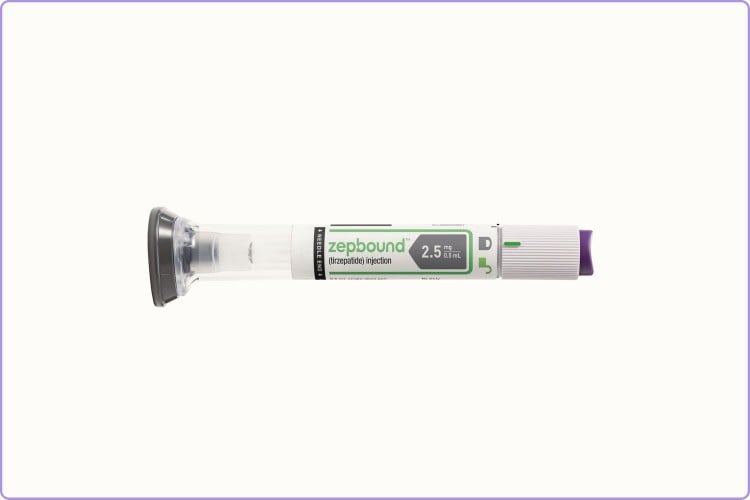- The FDA recently approved Zepbound, a new injectable medication, to treat chronic weight management.
- The medication features the same compound that’s in the type 2 diabetes medication Mounjaro, but competes directly with Wegovy, another weight loss drug.
- Experts recommend people have personalized conversations with a doctor to decide if a weight loss medication is the correct choice for their health.
There’s another new weight loss medication on the market.
On November 8, the Food and Drug Administration (FDA) approved Zepbound for adults with overweight or obesity and at least one weight-related condition, such as high blood pressure or high cholesterol.
The approval came after two studies found that people taking 15 milligrams (mg) of Zepbound lost 18% and 12% of their body weight respectively, as compared to a placebo group.
These results indicate the medication may be more potent than Wegovy.
“People have been waiting for the official FDA approval,” Rekha Kumar, MD, an endocrinologist at Weill Cornell Medicine and NewYork-Presbyterian, told Health.
“[Zepbound] is known to be the most effective weight loss medicine that currently exists,” she said.
Between Zepbound and Wegovy, as well as Mounjaro and Ozempic, the field of weight loss and type 2 diabetes medications is starting to become more crowded.
Here are the differences between Zepbound and existing injectable weight loss medications, as well as what consumers need to know when choosing the right medication.

Eli Lilly and Company
Comparing Wegovy, Ozempic, Zepbound, and Mounjaro
Zepbound, Wegovy, Mounjaro, and Ozempic all follow a simple pattern that makes it easier to understand how they compare to one another, Dina Peralta-Reich, MD, director of New York Weight Wellness Medicine, told Health.
Wegovy and Ozempic include the same compound—semaglutide—but are approved for managing weight loss and type 2 diabetes, respectively. The same is true for Zepbound and Mounjaro.
“Zepbound is tirzepatide, which already exists with the brand name of Mounjaro,” Peralta-Reich said. “Tirzepatide has been used for diabetes, but we have been using it off-label for the management of weight.”
Now that Zepbound is officially FDA approved, people looking to take tirzepatide for weight loss can seek out that medication instead of using Mounjaro—that medication is only approved to treat type 2 diabetes, though people who use it often lose weight.
Though Zepbound and Wegovy both help people lose weight, and Mounjaro and Ozempic help manage type 2 diabetes, the actual medications function differently.
Nearly Half of US Adults Would Take Weight Loss Drugs—But These Obstacles Get in the Way
Semaglutide Drugs: Ozempic and Wegovy
Ozempic was first approved by the FDA in late 2017, and has since made headlines both for its intended use—treating type 2 diabetes—and for its off-label weight loss use, particularly among celebrities.
The active ingredient in Ozempic is semaglutide, which copies the glucagon-like peptide-1 (GLP-1) hormone. This helps the body produce more insulin and signals a feeling of fullness in the brain.
Ozempic is taken via a weekly injection. To start, patients will take 0.25 mg for one month, and 0.50 mg for at least a month after that. Beyond that time frame, people can take either 1 or 2 mg to control blood sugar.
Novo Nordisk—the makers of Ozempic—don’t say how long people should take the medication for, only that it’s “safe and effective when used as indicated for the treatment of adults with type 2 diabetes to lower blood sugar.”
Semaglutide is also the active ingredient in Wegovy, which was first approved in June 2021.
Wegovy is also administered with a once-weekly injection.
At first, the dosing for Wegovy is also fairly similar to Ozempic—people on Wegovy can be bumped from 0.25 mg to 0.50 mg to 1 mg over three months. After four months, however, Wegovy is taken as a 1.7 mg injection, and finally a 2.4 mg injection from month five onwards.
Wegovy can have quite substantial effects—about one in three people who take the drug lose 20% of their body weight, or 46 pounds on average.
People who take semaglutide could see similar side effects from either Ozempic or Wegovy. The most common issues include nausea, vomiting, diarrhea, abdominal pain, and constipation, though more serious side effects such as pancreatitis, gastroparesis, and bowel obstruction have been reported.
What Is 'Food Noise'? How Drugs Like Ozempic and Wegovy Quiet Obsessive Thoughts About Food
Tirzepatide Drugs: Mounjaro and Zepbound
Tirzepatide is similar to semaglutide but functions a bit differently in the body.
The ingredient activates hormone receptors for GLP-1, and for another hormone called GIP, or glucose-dependent insulinotropic polypeptide, Jenny Tong, MD, MPH, an associate professor in the division of endocrinology at the University of Washington School of Medicine, told Health.
She explained that both of these hormones “increase insulin secretion to help disperse glucose.”
This is how Mounjaro, which is approved for type 2 diabetes management, can help lower blood sugar and improve insulin resistance.
Similarly to semaglutide, tirzepatide can help reduce a person’s food intake, which explains the drug’s ability to help people lose weight.
“GLP-1s help you decrease your appetite and increase your satiety. And it works at the level of the stomach, the brain, and in the pancreas,” Peralta-Reich said. “The GIP works at the level of the brain, decreasing appetite and it also supposedly improves how your body breaks down fats and sugars.”
The chemical compound for both Mounjaro and Zepbound is the same, as is the dosing, Kumar explained.
Mounjaro and Zepbound are both given as a 2.5 mg weekly injection for one month, then increased to 5 mg each week for at least another month. Beyond that, people can slowly increase their dosage if necessary—to a maximum of 15 mg.
Zepbound’s effect on a person’s weight can be even more substantial than Wegovy’s. At the highest dose, one in three people lost 25% of their body weight, or 58 pounds.
Side effects also seem to be “very similar” to semaglutide, Peralta-Reich said. Both active ingredients can cause nausea, diarrhea, vomiting, constipation, indigestion, and stomach pain, among other side effects.
Psyllium Husk Is Being Called the 'Poor Man's Ozempic'—Can It Really Help You Lose Weight?
More Options Is Good for Patients
Tirzepatide and semaglutide are not the only weight loss medications available.
The injectable medication liraglutide—called Victoza for type 2 diabetes and Saxenda for weight loss—can help people lose between 5 to 6% of their body weight, Tong explained.
But since the approval of those older drugs, weight loss medications have only improved.
“Just like in all of science, when things evolve and the next generation of science and medicine are developed, hopefully they work better or safer, or are better tolerated,” Kumar said. “And that seems to be what we’re seeing with tirzepatide versus semaglutide.”
The introduction of Zepbound is also a good sign for access, experts added.
“It’s great that this medication is becoming approved now, when we are facing a huge shortage of the current medications available like Ozempic, Wegovy, Saxenda,” Peralta-Reich said.
Kumar explained that introducing a new competitor to the market could also make this kind of drug easier to access financially.
Both liraglutide and semaglutide medications are manufactured by Novo Nordisk, she explained. But tirzepatide is manufactured by Eli Lilly and Co., which could provide incentives for the price to come down or become more accessible.
“[Novo Nordisk] has just been building upon its own molecules and dominating the diabetes and weight loss market,” she said. “There’s a new player making the most effective [medication] and there’s likely going to be other ones, too.”
What to Know About Hitting a Weight Loss Plateau While on Ozempic or Wegovy
Choosing Between Zepbound and Wegovy for Weight Loss
With relatively similar results, injection methods, and side effects, it’s difficult to fully endorse one medication over the other, experts agreed.
Again, available data now indicates that tirzepatide can cause more substantial weight loss than semaglutide.
Zepbound marks the first time that a weight loss drug can lead to weight loss similar to what’s typically seen with bariatric surgery, Tong noted.
Anecdotally, Peralta-Reich said her patients tend to find tirzepatide “easier to tolerate” with fewer gastrointestinal side effects as compared to Ozempic or Wegovy.
But this doesn’t mean that semaglutide is obsolete.
Having multiple options allows doctors to “troubleshoot” with their patients, switching to a different medication if one isn’t working well for someone, Kumar said.
Choosing between semaglutide and tirzepatide also depends on logistical factors like availability and insurance coverage, Peralta-Reich said.
“It’s individualized medicine,” she said. “This is a conversation that you should have with your physician.”
And before people get too caught up in the different types of weight loss medications available, it’s important to remember that focusing on diet and exercise is just as crucial for reducing obesity, Tong said.
“All those drugs, though there’s a percentage of weight loss, [that’s] on top of a lifestyle intervention,” she said. “We should still try to eat healthy, not only [staying] on a reduced-calorie diet in order to lose weight, but it also matters the quality of the food we choose.”
5 Tips for Healthy, Sustainable Weight Management, According to Registered Dietitians







:max_bytes(150000):strip_icc()/Health-GettyImages-1393991928-6eeadfb8e68b43a6b36aba58cc85d4d9.jpg)
